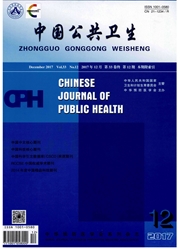

 中文摘要:
中文摘要:
目的研究广州市5岁以下儿童秋冬季诺如病毒(NVs)急性胃肠炎临床特征及危险因素。方法NVs急性胃肠炎临床特征的探讨采用软状病毒(RV)急性胃肠炎进行频数匹配的两样本研究,危险因素研究采用1:1配对病例对照研究。结果NVs胃肠炎最早出现的症状是呕吐47.0%(48/102),主要临床症状有呕吐80.3%(82/102)、发热52.9%(54/102)、脱水23.5%(24/102)和腹痛7.8%(8/102)等,与RV感染胃肠炎相似。NVs感染胃肠炎发病的危险因素是吃生冷食品,可疑危险因素是同胃肠炎患者接触及家庭内有腹泻患者,保护因素是勤剪指甲。结论NVs感染胃肠炎的临床特征及轻重程度与RV相似,其疾病负担仅次于轮状病毒;防止食物或水受到NVs污染以及避免同胃肠炎患者接触,保持良好的个人卫生习惯是预防NVs感染胃肠炎的有效措施。
 英文摘要:
英文摘要:
Objective To investigate the clinical characteristic and risk factor for sporadic NVs infections. Methods To assess the medical importance of NVs infection, the clinical characteristics of children infected with Norovirus(NVs) were compared with those found in patients infected with rotavirus. And a 1 : 1 case - control study was performed with the objective of identifying the risk factors for sporadic NVs infection. Results From 102 cases positive for NVs, 82 (80.3 % ) were associated with vomiting, 54 (52.9 % ) fever, 24 (23.5 % ) dehydration, 8 (7.8 % ) abdominal pains, and 48 (47.0 % ) with the first symptom of diarrhea. Consumption of crude or cold foods was a risk factor for sporadic NVs infection, contacting with gastroenteritis was a doubtful risk factor and to trim the nail was the protective factor. Conclusion NVs diarrhea clinical severity was equal to that in rotavirus. Efforts to prevent contamination of the potential vehicle(food or water) and personto - person NVs transmission and keep good personal hygiene could prevent the occurrence and spread of NVs infection.
 同期刊论文项目
同期刊论文项目
 同项目期刊论文
同项目期刊论文
 期刊信息
期刊信息
